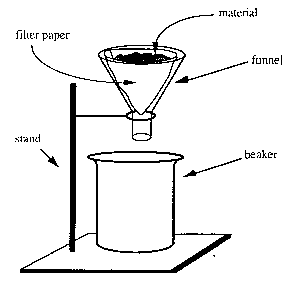Grade 9-12 Performance Task
Developed by: New York State Education Department (NYSED)
University of Buffalo and NORC (1991)
PART A
Introduction:
This laboratory test presents a problem. Your task
in Part A is to plan and design an experiment to solve the problem.
You will have 30 minutes to complete Part A. At the end
of the 30 minutes, your answer sheet will be collected. You will
then receive separate directions for Part B. In Part B you will
use materials and equipment provided in the laboratory kit to
collect experimental data for this problem. You may wish to do
your preliminary planning on the sheet labelled "Working
Copy." Write this plan on the appropriate answer sheet in
your test booklet.
Problem:
The retention of water by different materials affects
their use by plants and animals. Your problem is to design a method
to determine the water-holding capacity of sand, soil, and moss.
- State a HYPOTHESIS for this investigation that relates to
the water-holding capacity of sand, soil, and moss.
- Under the heading PROCEDURE list in order the steps you will
use to solve the problem. You may include a diagram to help
illustrate your plans for the experiment. Include any safety
procedures you would follow.
- Construct a DATA TABLE or indicate any other method that you
could use to record the observations and results that will be
obtained.
PLEASE NOTE: In Part A you are NOT to proceed
with any part of the actual experiment. You are just to plan and
organize a way to investigate the problem.
Materials:
ANSWER SHEET
PART A - Experiment Design
Organize your experiment design under the following
headings:
HYPOTHESIS, PROCEDURE, and DATA TABLE.
Use the front and back of these sheets if necessary.
HYPOTHESIS
PROCEDURE (Include diagram if appropriate)
DATA TABLE (For results and observations)
WORKING COPY
PART A - Experiment Design
This area is provided as a work space (or scrap
sheet).
Be sure to enter your final plan on the appropriate answer sheets.
No work on this sheet will be considered for credit.
PART B
Introduction:
You will have 50 minutes to complete this part.
Record your work for Part B on the answr sheet under the appropriate
headings. Perform the experiment by following the steps outlined
in the procedure (listed below). Under the heading RESULTS record
your observations and measurements for the experiment. Use written
statements, descriptive paragraphs, tables of data, and/or graphs
where appropriate. Under the heading CONCLUSIONS write an interpretation
of your results.
At the end of 50 minutes, your answer sheet for Part
B will be collected.

Procedure:
- Place the three funnels into the funnel supports. Place a beaker
under the lower end of each funnel. With the marking pencil, label
the first beaker SOIL, the second SAND, and the third beaker MOSS.
- Fold the filter papers to form cones. Insert them into the funnels.
- To the first funnel add 20 grams of soil. In the second funnel,
add 20 grams of sand. In the third funnel, add 20 grams of moss.
- Using a graduated cylinder, measure 150 ml of water. SLOWLY
pour this water into the funnel with the topsoil. Don't allow
the water to spill over the top of the filter paper. Record the
starting time in the chart. Note what time it will be in 10 minutes.
After exactly 10 minutes, remove the beaker in which water has
collected. Place a paper cup under the funnel if water is still
flowing.
- Repeat step 4 for the funnels with sand and moss. In each case
record teh starting times. Perform these steps while waiting for
the water to drain through the first funnel. Wait exactly 10 minutes
for each of these funnels, and remove the beakers into which the
water has drained. Use paper cups for catching any additional
water that is still flowing.
- Measure the quantity of water collected in each beaker. Record
your measurements and observations in the RESULTS section.
- From these results, state appropriate CONCLUSIONS.
ANSWER SHEET
PART B - Experiment Report
Organize your experiment report under the following
headings:
RESULTS and CONCLUSIONS.
Use the front and back of these sheets if necessary.
RESULTS
| |
Time Water Added |
Time Beaker Removed |
Amount of Water Collected |
| Soil |
|
|
|
| Sand |
|
|
|
| Moss |
|
|
|
CONCLUSIONS
|


